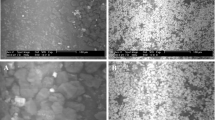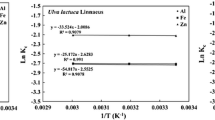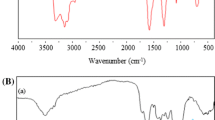Abstract
In this study, the red alga Bangia atropurpurea was modified with nitrilotriacetate (NTA) ligand and used for removal of U(VI) ions from aqueous solution using native form as a control system. The modification of B. atropurpurea biomass was realized by sequential treatment of algal biomass with glutaraldehyde and NTA ligand. Influence of U(VI) sorption parameters, such as contact time, adsorbent amount, medium pH and ionic strength, initial U(VI) ions concentration, and temperature on the removal performance of both algal biomasses were studied from aqueous solution. The hydroxyl, amino, carbonyl, and carboxyl groups were the main adsorptive groups of the biomasses as observed in FTIR data, and these groups can bind to U(VI) ions via electrostatic interactions. More than 78% of total sorption took place within 40 min, and equilibrium was established about 60 min. Maximum sorption capacities of the native and NTA-modified algal biomasses were found to be 190.2 and 328.8 mg g−1, respectively, at pH 5.5 and at 30 °C. The presence of other ionic species slightly decreased the U(VI) sorption capacity except that in Fe(III) ions. The sorption processes of U(VI) on the algal biomasses were described by the Langmuir and Temkin isotherms and pseudo-second-order kinetic models. The thermodynamic parameters, such as ΔH°, ΔS°, and ΔG°, show that the process is exothermic and spontaneous. It should be stated that the NTA-modified algal biomass has a high potential for the removal of U(VI) ions from aqueous solution.









Similar content being viewed by others
References
Ahmady-Asbchin S (2016) Response surface methodology for cadmium biosorption on Pseudomonas aeruginosa. Water Sci Technol 73:2608–2615
Akar T, Arslan S, Tunali-Akar S (2013) Utilization of Thamnidium elegans fungal culture in environmental cleanup: a reactive dye biosorption study. Ecol Eng 58:363–370
Arica TA, Ayas E, Arica MY (2017) Magnetic MCM-41 silica particles grafted with poly(glycidylmethacrylate) brush: modification and application for removal of direct dyes. Microporous Mesoporous Mater 243:164–175
Asnaoui H, Laaziri A, Khalis M (2015) Study of the kinetics and the adsorption isotherm of cadmium(II) from aqueous solution using green algae (Ulva lactuca) biomass. Water Sci Technol 72:1505–1515
Bagda E, Tuzen M, Sarı A (2017) Equilibrium, thermodynamic and kinetic investigations for biosorption of uranium with green algae (Cladophora hutchinsiae). J Environ Radioact 175-176:7–14
Bai J, Yao H, Fan F, Lin M, Zhang L, Ding H, Lei F, Wu X, Li X, Guo J, Qin Z (2010) Biosorption of uranium by chemically modified Rhodotorula glutinis. J Environ Radioact 101:969–973
Bampaiti YS, Aytas S, Pavlidou E, Noli F (2016) Investigation of uranium biosorption from aqueous solutions by Dictyopteris polypodioides Brown algae. J Radioanal Nucl Chem 307:1335–1343
Bayramoglu G, Arica MY (2009) Construction a hybrid biosorbent using Scenedesmus quadricauda and Ca-alginate for biosorption of Cu(II), Zn(II) and Ni(II): kinetics and equilibrium studies. Bioresour Technol 100:186–193
Bayramoglu G, Arica MY (2011) Preparation of a composite biosorbent using Scenedesmus quadricauda biomass and alginate/polyvinyl alcohol for removal of Cu(II) and Cd(II) ions: isotherms, kinetics, and thermodynamic studies. Water Air Soil Pollut 221:391–403
Bayramoglu G, Arica MY (2016) Amidoxime functionalized Trametes trogii pellets for removal of uranium (VI) from aqueous medium. J Radioanal Nucl Chem 307:373–384
Bayramoglu G, Arica MY (2017) Polyethylenimine and tris(2-aminoethyl)amine modified p(GA–EGMA) microbeads for sorption of uranium ions: equilibrium, kinetic and thermodynamic studies. J Radioanal Nucl Chem 312:293–303
Bayramoglu G, Akbulut A, Arica MY (2015) Study of polyethyleneimine and amidoxime functionalized hybrid biomass of Spirulina (Arthrospira) platensis for adsorption of uranium (VI) ion. Environ Sci Pollut Res 22:17998–18010
Birungi ZS, Chirwa EMN, Botai OJ (2017) Competitive adsorption in a ternary system of toxic metals and rare earth elements using Desmodesmus multivariabilis: empirical and kinetic modelling. J Appl Phycol DOI. doi:10.1007/s10811-017-1197-0
Camacho LM, Deng S, Parra RR (2010) Uranium removal from groundwater by natural clinoptilolite zeolite: effects of pH and initial feed concentration. J Hazard Mater 175:393–398
Cheng J, Yin W, Chang Z, Lundholm N, Jiang Z (2017) Biosorption capacity and kinetics of cadmium(II) on live and dead Chlorella vulgaris. J Appl Phycol 29:211–221
Das P, Bhattacharya D, Karmakarb P, Das S (2015) Influence of ionic strength on the interaction of THA and its Cu(II) complex with DNA helps to explain studies on various breast cancer cells. RSC Adv 5:73099–73111
Dixit S, Singh DP (2014) An evaluation of phycoremediation potential of cyanobacterium Nostoc muscorum: characterization of heavy metal removal efficiency. J Appl Phycol 26:1331–1342
Espinosa-Ortiz EJ, Shakya M, Jain R, Rene ER, van Hullebusch ED, Lens PNL (2016) Sorption of zinc onto elemental selenium nanoparticles immobilized in Phanerochaete chrysosporium pellets. Environ Sci Pollut Res 23:21619–21630
Francis AJ, Dodge CJ (1998) Remediation of soils and wastes contaminated with uranium and toxic metals. Environ Sci Technol 32:3993–3998
Gottlieb LS, Husen LA (1982) Lung cancer among Navajo uranium miners. Chest 81:449–452
He S, Ruan B, Zheng Y, Zhou X, Xu X (2014) Immobilization of chlorine dioxide modified cells for uranium absorption. J Environ Radioact 137:46–51
Heidari F, Riahi H, Aghamiri MR, Shariatmadari Z, Zakeri F (2017) Isolation of an efficient biosorbent of radionuclides (226Ra, 238U): green algae from high-background radiation areas in Iran. J Appl Phycol. doi:10.1007/s10811-017-1151-1
Ho YS, McKay G (2002) Application of kinetic models to the sorption of copper (II) on to peat. Adsorpt Sci Technol 20:8
Jena J, Pradhan N, Aishvarya V, Nayak RR, Dash BP, Sukla LB, Panda PK, Mishra BK (2015) Biological sequestration and retention of cadmium as CdS nanoparticles by the microalga Scenedesmus-24. J Appl Phycol 27:2251–2260
Ji G, Zhu G, Wang X, Wei Y, Yuan J, Gao C (2017) Preparation of amidoxime functionalized SBA-15 with platelet shape and adsorption property of U(VI). Sep Purif Technol 174:455–465
Jiang J, Zhang N, Yang X, Song L, Yang S (2016) Toxic metal biosorption by macrocolonies of cyanobacterium Nostoc sphaeroides Kützing. J Appl Phycol 28:2265–2277
Katsoyiannis IA (2007) Carbonate effects and pH-dependence of uranium sorption onto bacteriogenic iron oxides: kinetic and equilibrium studies. J Hazard Mater B 139:31–37
Krestou DP (2004) Uranium (VI) speciation diagrams in the UO2 2+/CO3 2−/H2O system at 25°C. Eur J Miner Process Environ Prot 4:113–129
Lee KY, Kim KW, Baek YJ, Chung DY, Lee EH, Lee SY, Moon JK (2014) Biosorption of uranium(VI) from aqueous solution by biomass of brown algae Laminaria japonica. Water Sci Technol 70:136–143
Liu Y-H, Wang Y-Q, Zhang Z-B, Cao X-H, Nie W-B, Li Q, Hua R (2013) Removal of uranium from aqueous solution by a low cost and high-efficient adsorbent. Appl Surf Sci 273:68–74
Mona S, Kaushik A (2015) Screening metal-dye-tolerant photoautotrophic microbes from textile wastewaters for biohydrogen production. J Appl Phycol 27:1185–1194
Nasab SMH, Naji A, Yousefzadi M (2017) Kinetic and equilibrium studies on biosorption of cadmium(II) from aqueous solution by Gracilaria corticata and agar extraction algal waste. J Appl Phycol 29:2107–2116
Pearson RG (1963) Hard and soft acids and bases. J Am Chem Soc 85:3533–3539
Rustemier O, Killmann E (1997) Electrostatic interactions and stability of poly-L-lysine covered polystyrene latex particles investigated by dynamic light scattering. J Colloid Interface Sci 290:360–367
Sarı A, Tuzen M (2009) Equilibrium, thermodynamic and kinetic studies on aluminum biosorption from aqueous solution by brown algae (Padina pavonica) biomass. J Hazard Mater 171:973–979
Shaaban AESM, Badawy RK, Mansour HA, Abdel-Rahman ME, Aboulsoud YIE (2017) Competitive algal biosorption of Al3+, Fe3+, and Zn2+ and treatment application of some industrial effluents from Borg El-Arab region. Egypt J Appl Phycol. doi:10.1007/s10811-017-1185-4
Starr RC, Zeikus JA (1993) UTEX-the culture collection of algae at the University of Texas at Austin. J Phycol 29:1–106
Wang F, Tan L, Liu Q, Li R, Li Z, Zhang H, Hu S, Liu L, Wang J (2015) Biosorption characteristics of uranium(VI) from aqueous solution by pollen pini. J Environ Radioact 150:93–98
Yokono M, Uchida H, Suzawa Y, Akiomoto S, Murakam A (2012) Stabilization and modulation of the phycobilisome by calcium in the calciphilic freshwater red alga Bangia atropurpurea. Biochim Biophys Acta 1817:306–311
Zhao M, Zhang C, Zeng G, Cheng M, Liu Y (2016) A combined biological removal of Cd2+ from aqueous solutions using Phanerochaete chrysosporium and rice straw. Ecotoxicol Environ Saf 130:87–92
Author information
Authors and Affiliations
Corresponding author
Electronic supplementary material
ESM 1
(DOCX 374 kb)
Rights and permissions
About this article
Cite this article
Bayramoglu, G., Akbulut, A., Acıkgoz-Erkaya, I. et al. Uranium sorption by native and nitrilotriacetate-modified Bangia atropurpurea biomass: kinetics and thermodynamics. J Appl Phycol 30, 649–661 (2018). https://doi.org/10.1007/s10811-017-1238-8
Received:
Revised:
Accepted:
Published:
Issue Date:
DOI: https://doi.org/10.1007/s10811-017-1238-8




